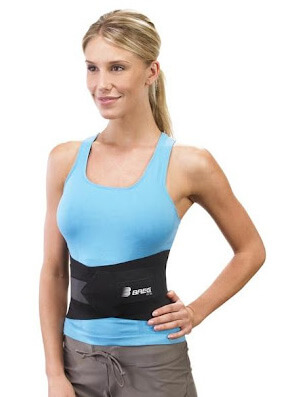When Should You Wear a Low Back Brace?


Michelle DeMarchi
BSc PT, DOMP
Physiotherapist, Pelvic Health Physiotherapist, Bracing Specialist
Are you experiencing low back pain that is interfering with your work, daily activities, exercise, or sports?
If so, you are not alone.
“Back pain is one of the most prevalent problems in Canada. 4 out of 5 adults will experience it at some point in their lives, however the majority occurs between the ages of 30-50” – Michelle DeMarchi
The good news is that back bracing, in addition to physiotherapy treatment or chiropractic treatment and exercise may be able to help.
Braces are meant to be one small aspect of a large comprehensive treatment plan and are often used in combination with physiotherapy, chiropractic, or massage therapy intervention.
A back brace can provide stability to your muscles, ligaments, and joints. This can help you if you’re recovering from surgery, recovering from an injury such as a muscle strain or disc herniation, or if you are suffering from chronic low back pain.

Your Doctor or Physiotherapist may prescribe you a Low Back Brace for the following reasons:
- To support your spine
- A back brace can help facilitate the healing process by taking some of the pressure off the muscles, ligaments, and joints in your spine.
- To relieve tension
- A brace may be used to carry some of the weight that is normally placed on the low back. This gives the muscles in your back a break which may help relieve some of your pain.
- To minimize movement in the spine
- Braces are sometimes recommended to you after surgery to restrict movements that may be damaging. This helps to create an optimal environment for healing.
Back braces may also be helpful for individuals with the following conditions:
- Spondylolisthesis
- Spondylolysis
- Osteoarthritis of the spine
- Spinal stenosis
- Vertebral compression fractures
- Scoliosis
In some cases, a back brace may not be right for you. Talking to a doctor, physiotherapist or chiropractor is recommended before using any type of brace. A thorough evaluation will not only help them determine whether a back brace can help you but also help determine the type of brace that’s best suited to your needs.
The Pros and Cons of Low Back Bracing
Some of the benefits that back braces provide can include:
- Decrease stress on the spine, making movements more comfortable
- Restrict twisting and bending motions that can prevent further injury
- Help you maintain good posture while bending and lifting
- Help injuries heal quicker by taking stress off the spine
The cons of wearing a back brace:
- It may provide a false sense of security
- There is a simple rule: if you can’t do it without the brace, don’t do it with the brace.
- It can cause additional injury if worn incorrectly
One of the most common problems with bracing is overuse. Using your back brace too much can cause the muscles in your back to become weak. This may cause you to become reliant on the brace and can result in further injury.
The bottom line is that low back braces can be very beneficial when used correctly. However, misuse has the potential to increase your pain or even worsen your injury. When using a brace it’s important to only use it as you need it, and only as outlined by a healthcare professional.
2 Main Types of Low Back Braces
There are so many different types of low back braces…it’s hard to tell where to start!
It’s good to first identify the reason why you need the brace. Most low back braces can be grouped into 1 of 2 categories.

1. Rehabilitative Braces
These types of braces are most commonly used to support the spine following injury or surgery. These braces can be soft or rigid and provide a high level of support.
These braces:
- Supports the muscles, ligaments, and spine
- Protects the injured area by limiting motion
- Provide compression to reduce swelling

2. Functional Braces
Are you looking for a lightweight brace that can be easily worn during everyday activities, exercise, or sports?
A functional brace may be a good fit for you.
Functional braces are often flexible and provide light to moderate pressure on the torso to take pressure off weakened or injured areas. The increased flexibility of these braces allows for greater range of motion, allowing you to move and exercise with greater ease.
Functional braces:
- Provide compression to stabilize the spine
- Are lightweight and can fit under clothing
- Can be easily worn during exercise or sports
- Can allow you to perform certain movements such as lifting and twisting with less pain
There are many different types, styles, and designs of back braces for you to choose from. I know that this can be overwhelming!
The good news is that your doctor or physiotherapist can help guide you with selecting the right type for you.
Contact us today to book an appointment…or ask about a free 15-minute consultation with one of our physiotherapists or chiropractors. They will give you honest back pain advice and guidance on if a back brace is right for you.
This blog was written by Emily Karageorgos, a Physiotherapy student at the University of Toronto
If you want to learn more, read our blog on How to choose the Best Lower Back Brace for you.
Frequently Asked Questions about Back Brace
Where do I buy a back brace?
Some braces require a prescription and can be ordered by your doctor and purchased at pharmacies or orthopaedic clinics. However, you can also buy over the counter products from pharmacies or large retail stores. It is highly recommended that you consult with your doctor or physical therapist before purchasing a back brace.
Is a back brace covered by insurance?
It depends. Custom braces have certain requirements for insurance to cover payments.
Check with your insurer to make sure that they cover the cost of a brace and what they need to know about the brace before approval. Pre-approvals help speed this along.
